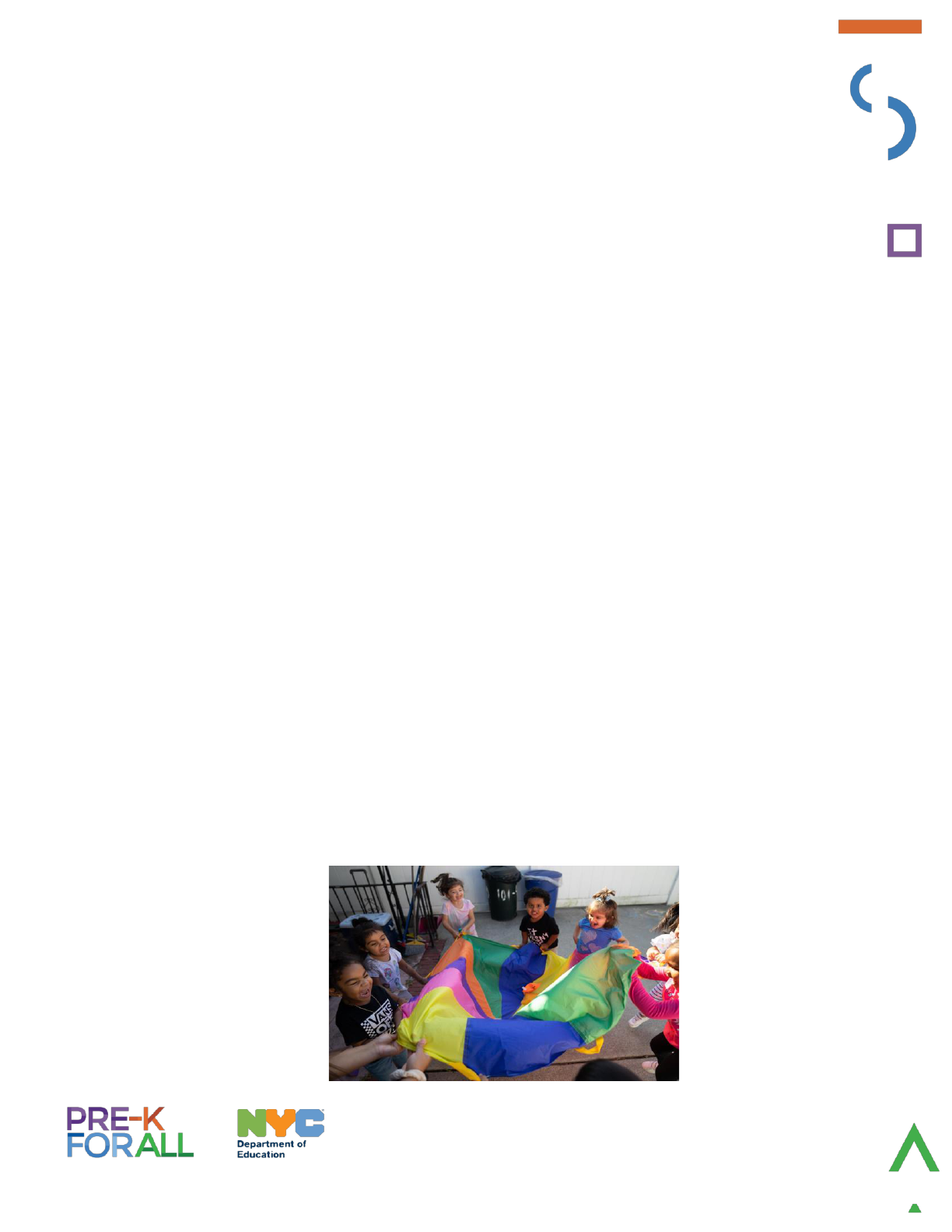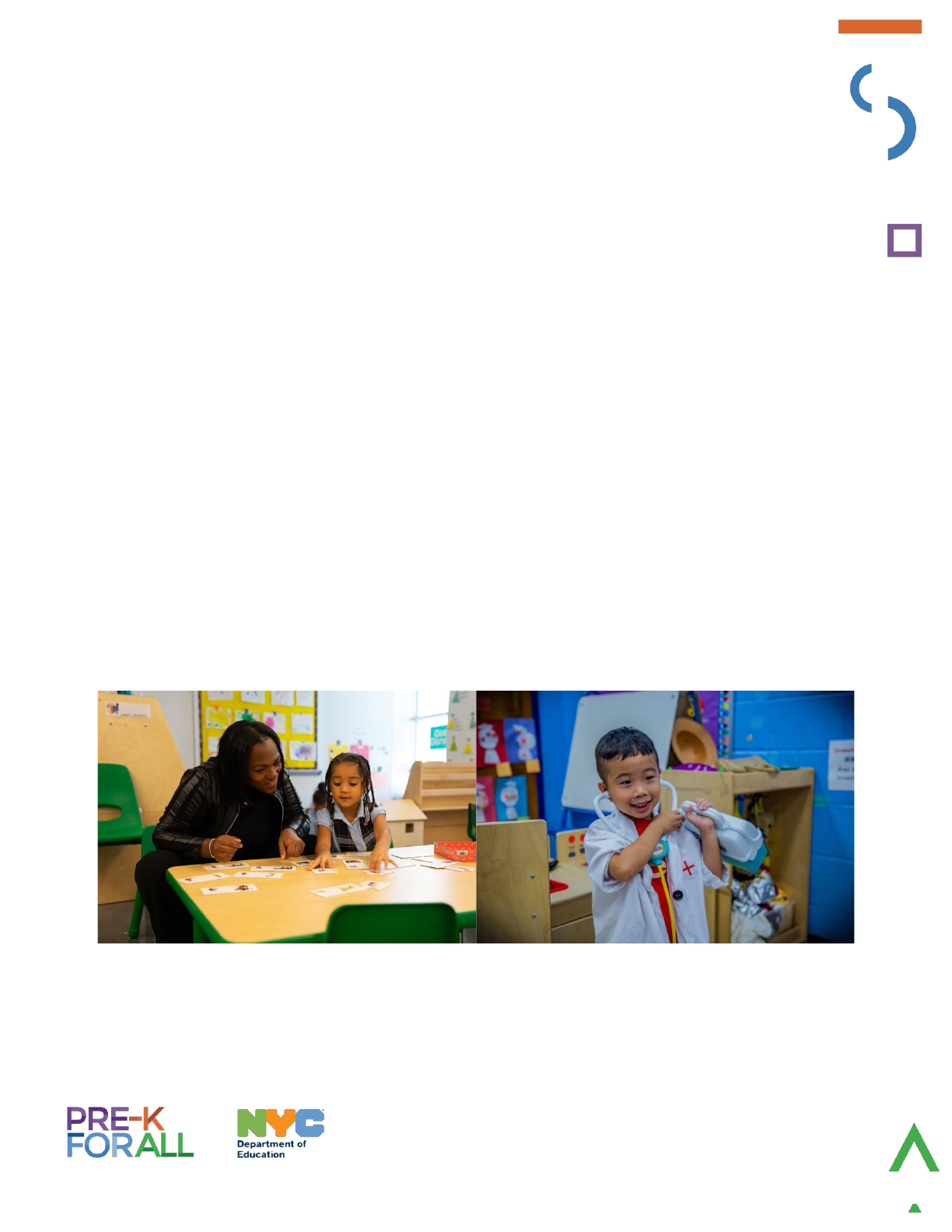
1
Social Emotional Wellbeing and Self Care in Early Childhood
Adapted from the NYCDOE Bridge to School Plan
The COVID-19 pandemic and recent attention on long standing racial injustice and social unrest have resulted in
significant stress, trauma, grief, and loss for our 1.1 million students and their families, as well as our nearly 150,000
educators. These realities require us to plan for a different school opening than previous years, one that centers the
humanity and lived experiences of our communities.
Beyond physical health and safety, our primary focus for the initial re-opening transition should be social-emotional
and mental wellness, ensuring that all staff and students have access to a foundational period of stabilization and
support. Centering community and social-emotional wellness at the start of school will create a strong foundation
for academic success and can reduce the number of students requiring intensive clinical mental health services later.
The themes of Community and Resilience are woven throughout the document, recognizing that strong
relationships and strengthening emotional competencies are central to trauma-informed care. A focus on
Community creates meaningful engagement and is the foundation for relationship building. A focus on Resilience
supports a strengths-based approach towards healing. This resource supports the social-emotional wellbeing of
students and adults to create a safe, supportive learning environment.
Early Childhood Best Practices are also Trauma-Informed Practices
As an early childhood educator you are well positioned to provide the responsive, caring, and predictable environments
and relationships that research has proven can mitigate stress and trauma. Some of these include:
● Responsive Caregiving: Meeting families, colleagues and children where they are. Practicing attunement- being
responsive to other’s emotions and how they are experiencing a situation. Ensuring supports are equitable
rather than equal, meaning each person gets what they need rather than each person getting the same thing.
● Unconditional Positive Regard/ Positive Interactions: Believing that one is worthy and capable even when one
is not feeling or acting that way. Using that belief as the foundation of all interactions with children and families.
● Predictability: Acknowledging and preparing others for change helps create predictability and limit stress. In
early childhood we use visuals, auditory cues, frequent reminders, and other strategies. This includes transitions
of all kinds, from entering a new classroom to moving from centers to lunch.
● Child-Led Play: Allowing children to take the lead in play supports their development and promotes a positive
self-identity. By following children’s lead we honor their autonomy, help them develop their identity, and build
their self-esteem. Play offers children the opportunity to honestly express their thoughts and feelings.
● Positive Behavior Support: Using best practices for instructive behavior management, rather than punitive.
Using strategies like positive narration, giving time for practicing new skills, explicitly teaching social and
emotional skills, etc… support children’s long-term emotional and mental health.
● Social Emotional Learning: Explicitly teaching social and emotional skills like self-regulation, understanding
emotions, and navigating social interactions (sharing, taking turns, being kind to others, saying “no”).
Supporting children’s identity development, building their self-esteem, and connecting them to their cultures
and communities.

2
→ The following pages offer concrete strategies and activities to center you and your students’ wellbeing.
Building Community
The sudden closure of schools and abrupt transition to remote learning in March created a profound disruption to the
consistent, predictable routines and relationships that schools provide. Following a period of isolation, it is necessary
to cultivate a foundational sense of community and belonging at school as a foundation for all of the additional
learning that will come throughout the year. The first few weeks of school will be a critical period to rally all members
of the school community. Human-centered Community Building experiences which hoist the power of positive
relationships (within and between staff and students) to the center of school life can transform uncertainty to hope.
This section will guide you in embracing this once-in-our-lifetime opportunity to rebuild stronger, more supportive
and more equitable learning environments.
Activities for Adults
● Small victories. Connect with your teaching team before the children arrive. Have each person write
for themselves what one thing they will accomplish today to consider it successful- why are you here?
Share with your colleagues.
○ Some examples might include: children felt welcome in the classroom, I made children smile, I
eased the anxiety of a family member.
● Leaving work at work. Before you go home, check in with yourself and your team. Consider using the
“Self-Care Going Home Checklist.” Post it somewhere where you can see it at the end of the day to
reflect and celebrate your work and accomplishments.
● Grounding exercises. Take a few minutes to yourself to decompress and ground in the moment
throughout the day. Try this: look around your space and find 5 things you can see, 4 things you can
touch, 3 things you can hear, 2 things you could smell, and 1 thing you could taste. As you name each
thing, think about the sensation it brings up for you.
● Team Connection. Take some time virtually or in person each day to connect with colleagues for
mutual support and connection. This could be your teaching team, the whole grade level, or across
grades. You can play a game or choose a discussion topic:
○ Personal History. Play “Story of My Name,” where each person shares a little about who
named them, why they chose their name, and/or any other stories related to their names.
○ Guiding Values. Consider your guiding value in being an educator- equity, growth, family, just
to name a few. Take a couple of minutes to write about the importance of that value to you
and your work. Share your guiding value with your teaching team and what it means to you.
○ Fun for fun’s sake. Play a silly game with your colleagues at the end of the day. Options
might include a simple board game, pictionary (where someone draws an idea and the other
tries to guess the item), or charades.
● Relationship Heroes. Think of someone who you consider excellent at building relationships. This
could be a friend, family member, community member, etc. (You can swap out “excellent at building

3
relationships” for any other SEL skill and follow the same format). As a teaching team, take turns
naming the people who came to mind for each of you and explain why you picked this person and
what this person does to build positive relationships.
Activities for Young Children
Each activity suggests whether it would be best implemented in-person, synchronous (virtually ‘live’ with
everyone logged in at the same time), or asynchronous (pre-recorded and shared virtually for families and
children to view on their own time). However each could be adapted for any format of learning.
● Home and School Families. In-person or synchronous
Read a story that shows different kinds of families. Invite children to share about their own families
and discuss how your classroom is kind of like being a part of another big family. Invite children to
create family portraits using whatever materials they would like during center time, if they are
interested. Post these in the classroom when finished.
● Puppet Show. In-person , synchronous, or asynchronous
During lunch, show children a short 2-3 minute puppet show that reinforces an expectation they have
been introduced to such as washing hands, using walking feet, or mealtime practices. After the short
puppet show, sit with children and encourage discussion about their day so far.
● Leaving with Love. In-person or synchronous
Before each child leaves for the day, write a short note about one thing the child enjoyed and a special
quality they bring to the class. Read the note to the children and let them know you appreciate having
them as part of your school family. Send the note home so families can share a moment with their
child celebrating their school day.
● Child-Led Play. In-Person or synchronous
Schedule time each week for a teacher to intentionally connect 1 on 1 with each child during play for
5-10 minutes, while they are in-person at the program. During that time, follow the child’s lead in
whatever they are doing, avoiding questions, and narrating their actions- i.e. “You are stacking the big
blocks on top of the smaller ones.” Research shows just 5 minutes of child-led play with an adult builds
connection, reduces anxiety and challenging behaviors, and strengthens children’s feeling of
ownership in the classroom. Our partners at NYU’s Center for Early Childhood and Development call
this using ‘FUN Skills’ (see more on this handout).
● Classroom Expectations. In-Person
In large group meetings, take time to co-create the classroom expectations with children. Let them
know the classroom should be a safe and loving place, then ask them what some important rules are
for the classroom. Summarize their answers with something simple like “So we think in our classroom
the agreements are to: Be Safe, Be Kind, and Have Fun! Some of the ways you think we can do that is to
use quiet voices, keep our hands on our own bodies, and make sure everyone gets a turn using the toys.”
● Cozy Corner. In-Person
In small groups, introduce and explore the Cozy Corner in your classroom. Let children know it is a
quiet place for them to come alone or with an adult whenever they want to. Introduce each toy/tool in
the corner and model how to use it. Give children time to touch and try out the various materials in
the Cozy Corner.

4
● Family Book. In-person, synchronous, or asynchronous
Ask families to provide photos of their families that can be kept in the classroom. Put photos together
in a book and read it to children during large or small group meetings, giving children a chance to talk
about their families. Teaching teams should include photos of their own families as well! Place the
completed book in the cozy corner for children to revisit. You could also add the family portraits
children created from the Day #1 suggestions.
○ Virtual consideration: When you ask families to send you family photos, show them- live or
in a pre-recording- a picture of your own family and tell them who is in the photo to help
them get to know you better.
● Feelings Chart. In-Person or synchronous
Show examples of different emotion faces using real pictures or drawing. Point out how you know
what the feeling is, for example “I see her nose is scrunched up and her lips are in a tight frown, I think
she is angry.” Have different children in the classroom show different emotion faces and take photos.
Compile and label them to create a feelings chart with no more 8 emotions featured. When choosing
the emotions, consider the range of emotions being shown, including neutral emotions like Content,
and ensure there is diversity in representation. Introduce the chart during large group, pointing out
the different emotions and hanging it in the classroom.
○ Virtual Consideration: Record yourself doing the activity above. Suggest families play a
game where they say the names of different emotions and then make the face together with
their child, ideally in a mirror. Ask families to take photos of different emotion faces as their
child makes them and send them to you.
○ Book connection: Consider reading or using pictures from the book “On Monday When it
Rained” by Cherryl Kachenmeister. Invite children to look in the mirror and copy the
expressions. Take pictures of the children mimicking the emotions. Discuss the emotions and
when we might experience them and recognize them in others.
● Similarities and Differences, transition activities. In-person or synchronous
Use transition activities that help children get to know each other and see some of their similarities
and differences. For example you could say: If you have a ____ (insert common family trait, i.e. sister,
cat) in your family you may go make a choice. Consider singing or chanting the words. Using your
knowledge of children’s diverse families, repeat with other traits until all children have transitioned to
centers.

5
Fostering Resiliency
In order to best position staff and students to successfully reengage in learning under unprecedented circumstances
and new learning modalities, schools must prioritize Social Emotional Learning (SEL) and Mental Health and
Wellness. Explicit teaching of SEL skills creates internal and external mechanisms that help with navigating and
withstanding the stress that is inevitable with daily living, amplified during times of crisis and lingers long after
traumatic events have passed. It also helps us honor our unique identities and empower us to express them in our
school community. In this section you will find tools to use as you work to actively develop socioemotional literacy,
fluency and empowerment in your school community.
Activities for Adults
Team Connections. Connect with yourself and/or teaching team (virtually or in person) to connect.
● My Identities. Complete the Social Identity Wheel. Take some time to self-reflect on the questions in
the center of the wheel. If you are comfortable, you might choose to share about your experience
completing the wheel with your colleagues.
● Self Portraits. Draw self-portraits or portraits of each other. Choose any art supplies you want and
draw portraits of each other within a time frame, such as 5 minutes. Reveal the portraits to each other
at the end of that time.
● Activating our Superpowers. What is the superpower you need to get through today? Through this
month? Share your answers with your teaching team and shout each other out when you see one
another using their superpower.
● Self-Care. Talk to your teaching team about how you practice self-care. Consider how you take time
to nourish one or more of the following: mind, body, soul, and spirit. How do you do it at home? At
work? How might your colleagues support you in that self-care while at work? Here’s some ideas to
get started:
○ Tiny self-care ideas:
○ Watch a short meditation video. Here is a 30 day meditation challenge which includes short
videos (5-10 minutes) to help you get started.
○ Try a grounding exercise. Here is more information on how to stay grounded with short
exercises.

6
Activities for Young Children
Each activity suggests whether it would be best implemented in-person, synchronous (virtually ‘live’ with
everyone logged in at the same time), or asynchronous (pre-recorded and shared virtually for families and
children to view on their own time). However each could be adapted for any format of learning.
● Big Feelings. In-Person or Synchronous
Read a story that shows a character navigating a strong emotion such as “When Sophie Gets Angry,
Really, Really Angry” or “Ruby Finds a Worry.” Invite students to share some of the ways they deal
with strong emotions in their own lives. Start off with an example of what you do when you are feeling
frustrated or nervous. Refer to your feelings chart from Week 1. Teach children a simple regulation
technique like deep breathing. For example, try this activity: “Pick an imaginary balloon in whatever
color you want. Now it takes 3 really deep breaths to blow it up. Ready?” Breathe deeply 3 times while
extending your hand to show the imaginary balloon growing. Then let it go and make a noise like a
balloon losing air. Do it again with children as practice.
○ Virtual Consideration: Do a read-aloud live or pre-recorded for children at home. If
synchronous, invite them to share their stories. If asynchronous, consider asking some
children ahead of time and writing down their experiences so you can share them in your
recording.
● Personal Boundaries. In-Person, Synchronous, or Asynchronous
Talk to children about setting boundaries in large or small group time. Let them know it is okay to say
“no” and still be kind! Use puppets or dolls to model what saying “no” can look like. For example, if
someone asks them for a toy they are not finished with they might respond with: “Not right now. You
can have it when I’m done.” You may show the puppets engaging in this interaction first in a way that
produces a negative reaction- pushing or yelling- and narrate what the consequences are: “Oh, Tiger is
feeling scared because Bear yelled at her when she asked a question.” And then again using the
preferred language mentioned above with a different outcome: “Tiger still really wants to play with the
toolbox in block area and sometimes waiting is really hard, but now she knows she can keep playing at
the art area until Bear is finished with the toolbox.”
● Everyday Superheroes. In-Person or Synchronous
Introduce a class project about Classroom Superpowers. Share with children that a superpower is
something you are really good at. Give an example of your own superpower, for example: being a
great friend, listening to other people, or being an artist. Ask children what their superpowers are and
write them down on chart paper. Invite children to create or draw their superpowers over the week
during center time. Collect their art, photos of their block structures or dramatic play costumes about
their superpower and compile them into a small art exhibit with the list of superpowers you collected.
When introducing this activity you might consider wearing a cape or a superhero mask to further
engage children.
○ Virtual consideration: Record or in a live meeting, introduce the idea of superpower and
invite children to create representations while they are at home. Show a few examples-
drawn, shown in blocks, or acted out. Ask families to document their experiences.

7
■ Extension Idea: Have children create superhero tools or badges in whatever form
they would like. They can keep in their cubbies and get them whenever they feel the
need to activate their superpower.
● Praising a Growth Mindset. In-Person, Synchronous, or Asynchronous
Be intentional about giving children praise based on their growth and effort rather than outcomes.
Rather than say: “Great job opening your milk!” you might say: “I noticed you kept trying when it was
hard to get your milk open, then asked me for help. You were really determined to try your best!”
● Classroom Jobs. In-Person
Create a job chart for your group of children. Create a visual with various responsibilities children can
take on throughout the day, ensuring there are enough for each child to take one on every day. In the
mornings at large group meeting, pull pictures of children at random and assign them to a job. Ensure
children are getting chances to do different jobs and support them throughout the day. If they do not
get the job they want, they may experience some big feelings. Make sure an adult is available to help
them navigate those and remind them of their options- deep breaths, they will get a turn sometime
soon- waiting is hard, and using the cozy corner.
● Stronger Together, People Who Help Us. In-Person, Synchronous, or Asynchronous
Who are the people who help us at home and school? Encourage children to discuss who is important
and why (i.e. friends, relatives, mail carrier, building super, neighbors). Draw pictures of these people
and post them in the classroom.
○ Virtual Consideration: Ask families to engage in the above activity and share their drawings
with you.
